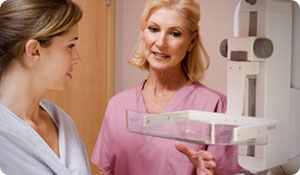
See what people are saying about this article on our Facebook page!![]()
"But no one in my family ever had breast cancer."
This is an all-too-common response from women newly diagnosed with breast cancer. While family history is a significant risk factor, only about one in 10 women diagnosed have family members with breast cancer. Early detection is important for all women.
Detecting Breast Cancer
For years, women were taught that Self Breast Exams (SBEs) were important for catching breast cancer early. During SBEs, women examine their own breast for changes, abnormalities, or lumps. Newer research finds that SBEs are of little or no use in reducing death risk from breast cancer. Furthermore, when women find lumps that are not cancerous, it often leads to potentially risky and unnecessary medical procedures. Despite the research, many healthcare providers still encourage women to continue SBEs.
So, if SBEs are not useful in reducing death risk from breast cancer, how do we detect cancer early?
Understand Your Risk Factors
The primary risk factor for breast cancer is being a woman. The second most significant risk factor is being over age 50. There are a few other important risk factors: the age you began menstruating, your ethnicity, reproductive history, and prior breast biopsies. Knowing how likely you are to develop breast cancer will help you and your physician determine the most appropriate screening routine and frequency for you.
Just by answering a few questions, you can calculate your own risk using the National Cancer Institute's online Breast Cancer Risk Assessment Tool.
Clinical Breast Exams
Have your breasts examined by a qualified healthcare provider, who will check the size and shape of your breasts, the skin on your breast, and your nipples. She will also feel for lumps in your breast.
Mammogram and Other Imaging Tests
Mammograms are used for both screening (looking for cancer in women with no signs) and as a diagnostic tool to collect more information when the radiologist finds something suspicious on a screening mammogram.
Ultrasounds and MRIs can also provide detailed images of the breast. As you know, there is a lot of controversy about when women should begin having mammograms and how often they should repeat them. You and your physician should discuss your risk factors, weigh the pros and cons of mammograms, and determine what's best for you.
These are tools for detecting existing cancer. They do not take into consideration all the steps you can take to prevent, or at least reduce your risk of, developing breast cancer, such as not smoking and exercising regularly.
See what people are saying about this article on our Facebook page!![]()
Sources:
Childs, Dan. "Experts Debate Value of Breast Self-Exams." ABC News. Web. 16 July 2008.
http://abcnews.go.com/Health/OnCallPlusBreastCancerNews/Story?id=5380790
National Cancer Institute. "The Breast Cancer Risk Assessment Tool." Web. 28 April 2008.
http://www.cancer.gov/bcrisktool/
National Cancer Institute. "What you need to know about breast cancer." Web. 15 October 2009.
http://www.cancer.gov/cancertopics/wyntk/breast
National Cancer Institute. "Cancer risk: understanding the puzzle." Web.
http://understandingrisk.cancer.gov/





